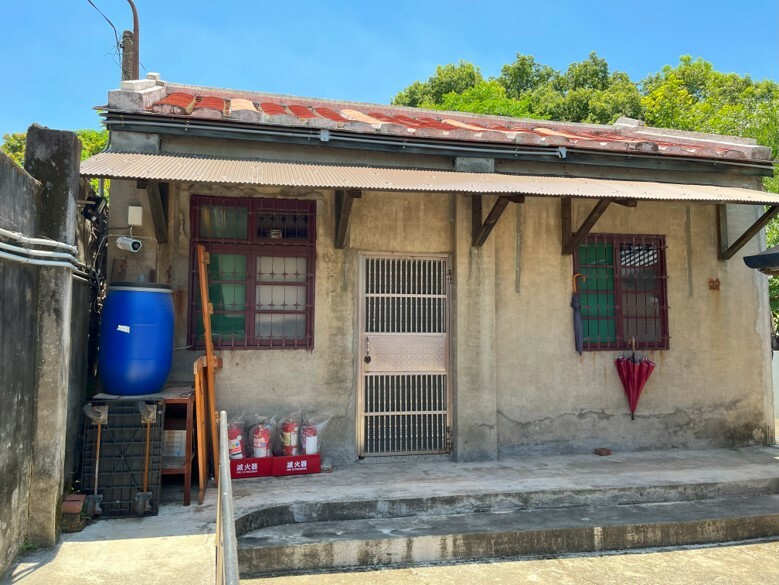
[A preserved MDV dwelling in Taipei. Source: author's own, taken on 23 July 2022]
Several Western countries share a similar history of post-war housing development and also face the long-term influence of the oil crises and neoliberalism. These contexts and influences lead to the development of the concept of housing financialisation, which has received growing academic attention, especially after the Global Financial Crisis. However, financialisation discourses circulating outside Anglophone countries are still lacking empirical underpinnings, and what happens in other countries doesn’t necessarily fit in the local context. We need to locate our discussion within specific historical and urban relations. Taiwan has a post-war housing history different from the West, and I seek to improve our understanding through the case of Military Dependents’ Villages (MDVs), which are famous in Taiwan but less known to international debates. Due to the scarcity of literature on MDV housing, the purpose of this paper is to establish a preliminary comprehension of political and financial mechanisms, providing new knowledge and possible entry points for researchers in opening up a new set of discussions.
MDVs were unique outgrowths of war and mass migration. While about one million people retreated to Taiwan with the Kuomintang (KMT) government after the defeat of the Chinese Civil War in 1949, the MDVs appeared as collective settlements accommodating partial military personnel and their dependents among these immigrants and refugees, and by the 1990s, more than nine hundred MDVs with approximately 100,000 dwellings had been built, scattered around Taiwan and the surrounding islands. Some scholars estimate that in the 1980s, about 3 to 5 percent of the total population were or once were MDV residents. About 20 percent of villages were located in Taipei City, making it the city with the most MDVs in number.
Before the mid-1950s, most of the MDVs were crude one-storey dwellings built by residents using simple and makeshift materials. This notion of temporariness was largely because many immigrants believed that sooner or later the government would launch a counterattack, and returning to the Mainland was expected. These settlements were gradually regulated and more were built as the feasibility of counterattacks decreased after the mid-1950s. The MDV residents only had residence permits rather than actual homeownership. This housing for the cohorts of specific roles and occupations began to be regenerated and privatised in the late 1970s. The gradually deteriorating MDVs were engulfed by rapidly modernised and expanding cities, turning into the spots with potentially high market value scattered in the urban area. The large-scale reconstruction was initially integrated into the public housing projects from the 1970s, which was used as a tool by the authoritarian government to tackle rocketing housing prices caused by rapid urbanisation, economic growth, financial deregulation, and the oil crises. This comprehensive reconstruction came to an end in 2016.
Based on the integration of the results of secondary documentary analysis and qualitative interviews with several experts and stakeholders, I depict the complex fiscal frameworks within the reconstruction process. Constrained by the low priority of housing measures (compared to economic development and national defence) and the lack of government funding, the military and the state reduced the financial burden of the government through privatisation, and introduced financial means to bring MDV residents into the fiscal balance scheme to ensure the financial viability of MDV reconstruction. Residents of different MDVs were relocated from low-density residential areas to specific sites of newly-built high-rises with high residential density. Most of the rest of the public land that was cleared and released, and sold to private developers or the public housing authority, and the military used the revenue to subsidise most, but not all, of the construction costs. The remaining expenses were borne by MDV residents themselves to obtain homeownership. In order to ensure the stability of cash flow and complete the reconstruction and housing supply of MDVs as planned, the military borrowed from banks with public properties. In addition, residents could use bank loans to pay the owed amount, lowering the threshold of access. The individual economic and social reproduction of everyday life was then interdependent with the state fiscal framework and balance.
Home purchase subsidies granted by the military depended on the total costs of construction, which covered the value of the land. Selecting urban peripheries with lower land prices as reconstruction sites can reduce the amount of subsidy provided by the military to a certain extent. The pursuit of financial balance led to the impact on urban spaces: I found the trend of MDV residents being concentrated in the urban fringe areas of Taipei City after the MDV reconstruction. Furthermore, it is the loss of public property that lurks in the shadow of reducing the financial burden on the state, and both the privatised reconstructed MDVs and the lands sold to private developers increase the number of houses entering the fast-growing market after financial deregulation. The inclusion of financial instruments was to achieve the policy goals efficiently, and the instruments themselves were not complicated. However, this brought more and more households into a housing system increasingly centred on financial logics and imperatives, which contributed to shifting housing orientations and practices i.e. housing as an asset and the internalisation of homeownership as a normative aspiration. MDVs were basic infrastructure provided to a specific group, and their land was stripped out as a strategic resource to serve the political purpose of urban developmentalism.
This research shows that historicising MDVs and their financialisation in Taipei not only evidences the involved local complexities and contestations but can also shed new light on the contemporary housing context. Further lines of inquiry might include the identification and more detailed analysis of the relationship between the promotion of the reconstruction policies and political support, as well as the impact of reconstruction on residents' practical life over time.

Author
Yu-Tung Wu is a third-year PhD student at the University of Sheffield, focusing on housing financialisation in Taiwan and the Military Dependents’ Villages. He completed his undergraduate in 2018 in urban planning at the National Cheng Kung University, Taiwan, and was awarded the degree of MSc in Cities and Global Development by the University of Sheffield in 2020.
His current research explores the actual influence of housing financialisation on daily lives and housing mobility and focuses on how the nuanced policy decision-making process was embedded in the wider context, thereby affecting the transformation of urban spaces and the built environment. The results of the study aim to connect neoliberalism with local housing and residential lives, revealing the inequalities tolerated by governments at various levels due to political and economic realities. At the same time, it also introduces Taiwan’s unique housing landscape, the Military Dependents’ Villages, to relevant international academic discussions, providing new experiences and ideas for the housing financialisation discourses in East Asia.






